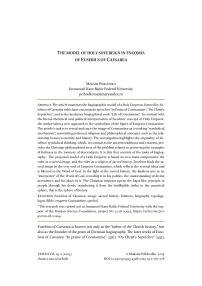The model of holy sovereign in encomia of Eusebius of Caesarea
Автор: Maksim Prikhodko
Журнал: Schole. Философское антиковедение и классическая традиция @classics-nsu-schole
Рубрика: Статьи
Статья в выпуске: 2 т.19, 2025 года.
Бесплатный доступ
The article examines the hagiographic model of a Holy Emperor, formed by Eusebius of Caesarea in his later encomiastic speeches “In Praise of Constantine”, “On Christ’s Sepulchre”, and in the laudatory biographical work “Life of Constantine”. In contrast with the literal, rhetorical and political interpretation of Eusebius’ concept of Holy Emperor, the author takes a new approach to the symbolism of the figure of Emperor Constantine. The article’s task is to reveal and trace the image of Constantine as a working “symbolical mechanism”, associating profound religious and philosophical concepts, such as the relationship between eternity and history. The investigation highlights the originality of Eusebius’ symbolical thinking, which, in contrast to the ancient traditions and customs, provides the Christian-philosophical view of the problem related to preserving the examples of holiness in the memory of descendants. It is this that consists of the tasks of hagiography. The proposed model of a Holy Emperor is based on two main components: the ruler as a sacred image, and the ruler as a subject of sacred history. Eusebius finds the sacred image in the very soul of Emperor Constantine, which reflects the eternal ideas and is likened to the Word of God. In the light of the sacred history, the Basileus acts as an “interpreter” of the Word of God, revealing it in his politics, the understanding of divine providence and his place in it. The Christian emperor opens the logos-like principle in people through his deeds, transferring it from the intelligible realm to the empirical sphere that is the sphere of history.
Eusebius of Caesarea, image, sacred history, holiness, biography, typology, logos, Bible, emperor Constantine, symbol
Короткий адрес: https://sciup.org/147251468
IDR: 147251468 | DOI: 10.25205/1995-4328-2025-19-2-767-778


